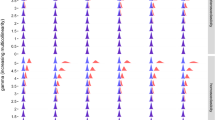Abstract
Two non-standard techniques – the Rasch Model and Nonlinear Principal Components Analysis – originally proposed in other fields are presented and discussed to measure the opinion of European citizens about utilities. The Eurobarometer survey data are thus considered. The potential of both methods and their complementary use are highlighted; in particular the methods allow the questionnaire to be calibrated, the role of different services and aspects of service to be established, and the consumer satisfaction to be assessed and compared among European countries, different years and services.
Similar content being viewed by others
References
ANDRICH, D. (1988), “A General Form of Rasch’s Extended Logistic Model for Partial Credit Scoring”, Applied Measurement in Education, I, 363–378.
ANDRICH, D., SHERIDAN, B., LYNE, A., and LUO G. (2000), RUMM: A Windows-Based Item Analysis Program Employing Rasch One-Dimensional Measurement Models, Perth, Australia: Murdoch University.
ANDRICH, D. (2004), “Controversy and the Rasch Model: A Characteristic of Incompatible Paradigms?”, Medical Care, 42(1), 7–14.
DE BATTISTI, F., NICOLINI, G., and SALINI, S. (2005), “The Rasch Model to Measure the Service Quality”, The ICFAI Journal of Services Marketing, 3(3), 58–80.
DE BATTISTI, F., NICOLINI, G, and SALINI S. (2010), “The Rasch Model in Customer Satisfaction Survey Data”, Qualitative Technology and Quantitative Managment, 7(1), 15–34.
EUROBAROMETER (2002, 2004, 2006), Report No. 58-2002, Report No. 53-2004, Report No. 62.1-2006, http://ec.europa.eu/public_opinion/archives/eb_arch_en.htm.
FERRARI, P.A., ANNONI, P., and SALINI, S. (2005), A Comparison Between Alternative Models for Environmental Ordinal Data: Nonlinear PCA vs Rasch Analysis, 20th IWSM 2005, Sydney.
FERRARI, P.A., ANNONI, P., and MANZI, G. (2010), “Evaluation and Comparison of European Countries: Public Opinion on Services”, Quality & Quantity, 44 (6), 1191–1205.
FERRARI, P.A., and MANZI, G. (2010), “Nonlinear Principal Components Analysis as a Tool for the Evaluation of Customer Satisfaction”, Qualitative Technology and Quantitative Managment, 7(2), 117–132.
FIORIO, C.V., FLORIO, M., SALINI, S., and FERRARI, P.A. (2007), “Consumers’ Attitudes on Services of General Interest in the EU: Accessibility, Price and Quality 2000-2004”, in: Servizi Pubblici: Nuove Tendenze nella Regolamentazione, nella Produzione e nel Finanziamento; eds. M. Marrelli, F. Padovano, and I. Rizzo, Milano, Italy: Franco Angeli, pp. 83-110.
GIFI, A. (1990), Nonlinear Multivariate Analysis, New York: Wiley.
GREEN, P.E., and SRINIVASAN, V. (1978), “Conjoint Analysis in Consumer Research: Issues and Outlook”, Journal of Consumer Research, 5(2), 103–123.
HAMBLETON, R.K., SWAMINATHAN, H., and ROGERS, H. J. (1991), Fundamentals of Item Response Theory, Newbury Park, CA: Sage Press.
HEISER, W.J., and MEULMAN, J.J. (1994), “Homogeneity Analysis: Exploring the Distribution of Variables and Their Nonlinear Relationship”, in Correspondence Analysis in the Social Sciences: Recent Developments and Applications, eds. M.J. Greenacre. and J. Blasius, New York: Academic Press, Harcourt Brace & Company, pp. 179–209.
LINTING, M., MEULMAN, J. J., GROENEN, P. J. F., and VAN DER KOOIJ, A. J. (2007a), “Nonlinear Principal Components Analysis: Introduction and Application”, Psychological Methods, 12, 336–358.
LINTING, M., MEULMAN, J.J., GROENEN, P.J.F., and VAN DER KOOIJ, A.J. (2007b), “Stability of Nonlinear Principal Components Analysis: An Empirical Study Using the Balanced Bootstrap”, Psychological Methods, 12, 359–379.
MEULMAN, J.J., VAN DER KOOIJ, A.J., and HEISER, W.J. (2004), “Principal Components Analysis with Nonlinear Optimal Scaling Transformations for Ordinal and Nominal Data”, in Handbook of Quantitative Methodology for the Social Sciences, ed. D. Kaplan, Thousand Oaks, CA: Sage Publications, Inc., pp. 49–70.
MICHAILIDIS, G., and DE LEEUW, J. (1998), “The Gifi System of Descriptive Multivariate Analysis, Statistical Science, 13, 307–336.
RASCH, G., (1960), Probabilistic Models for Some Intelligence and Attainment Tests, Expanded edition (1980), Copenhagen, Danish Institute for Educational Research, with foreword and afterword by B.D. Wright, Chicago: The University of Chicago Press.
QTQM (2010), Qualitative Technology Quantitative Management, Special Issue, “Non-Standard Analysis of Customer Satisfaction Survey Data”, 7(1,2).
SALINI, S., and KENETT, R. (2009), “Bayesian Networks of Customer Satisfaction Survey Data”, Journal of Applied Statistics, 36(11), 1177–1189.
VICHI, M., ROCCI, R., and KIERS, H.A.L. (2007), “Simultaneous Component and Clustering Models for Three-Way Data: Within and Between Approaches” Journal of Classification, 24(1), 71–98.
Author information
Authors and Affiliations
Corresponding author
Additional information
This paper has been supported under the VI Framework Program (project title: “Understanding Privatisation Policy: Political Economy and Welfare Effects”) of the European Union. The authors are very grateful to the anonymous reviewers for their precious comments and suggestions.
Rights and permissions
About this article
Cite this article
Ferrari, P.A., Salini, S. Complementary Use of Rasch Models and Nonlinear Principal Components Analysis in the Assessment of the Opinion of Europeans About Utilities. J Classif 28, 53–69 (2011). https://doi.org/10.1007/s00357-011-9081-0
Published:
Issue Date:
DOI: https://doi.org/10.1007/s00357-011-9081-0




